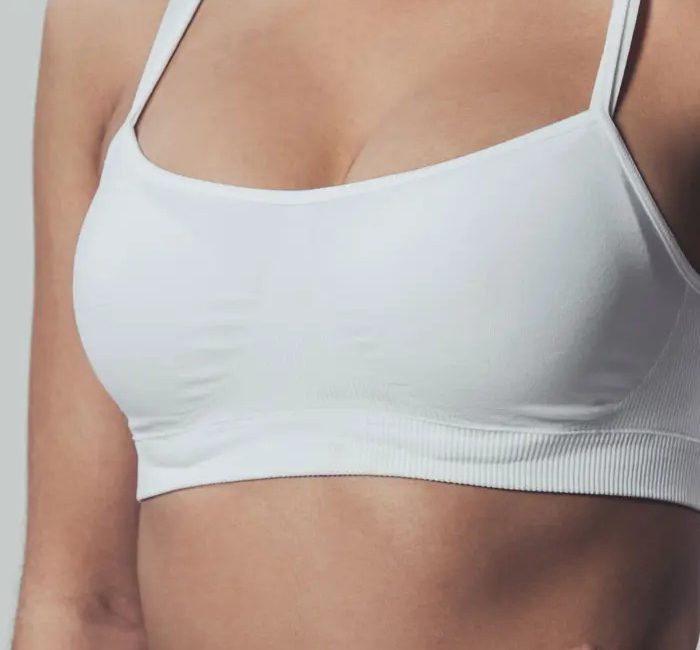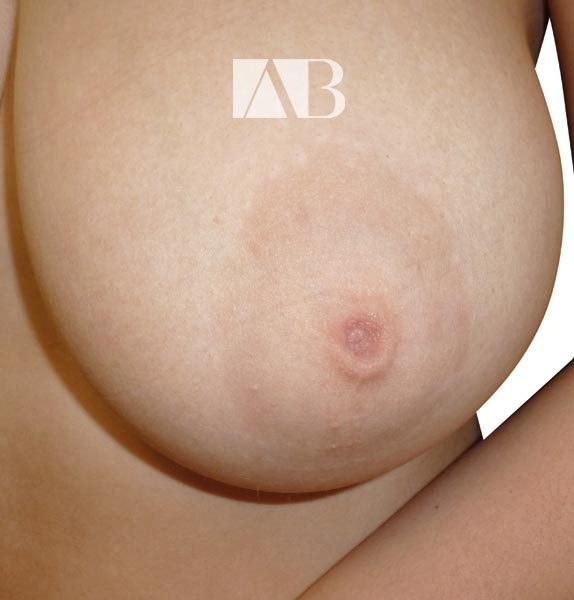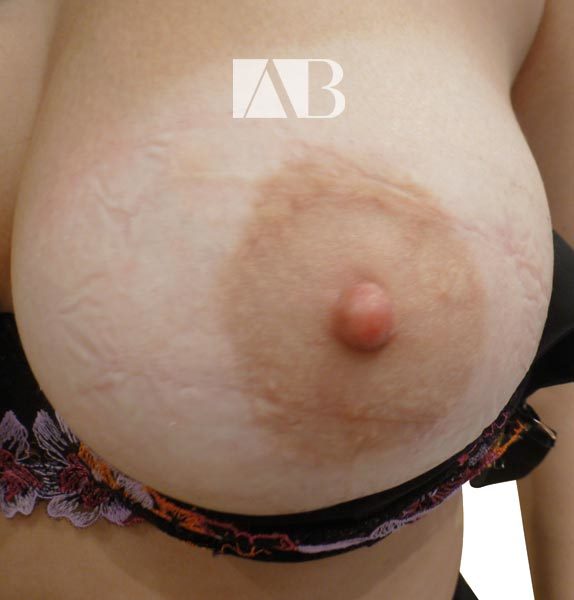Procedures
Inverted Nipple Correction

Surgery for inverted nipples is a type of aesthetic surgery designed to rectify nipples that are retracted or “inverted” instead of being projected outward. This condition can be congenital, emerge during adolescence, or occur due to changes in the breast structure over a period of time. Certain women may choose to undergo this surgical procedure for cosmetic purposes, while others might opt for it to alleviate issues associated with breastfeeding or personal unease.
Anca Breahna, a skilled and experienced consultant plastic surgeon, performs different types of breast procedures to help patients achieve their aesthetic goals. Inverted nipple surgery is a safe procedure when carried out by an experienced surgeon like Anca Breahna. During a thorough consultation, your overall health and suitability for the procedure will be assessed. The procedure itself is not painful as the area is numbed, ensuring your comfort throughout. Post-surgery, you may experience tenderness and bruising, which usually subsides within a few days with the help of over-the-counter painkillers.
At a glance
1 hour
Local anaesthetic
Day case
1 week
Up to 4 weeks
Table of Contents
What Is Inverted Nipple Surgery?
Inverted nipple surgery is a type of plastic surgery designed to correct the condition of inverted nipples. But what exactly is an inverted nipple? In the most straightforward terms, an inverted nipple is one that is turned inward instead of pointing outward. This condition can either be a natural trait that a person is born with, or it can develop over time due to various circumstances, such as breastfeeding or infections.
Inverted nipples can occur in both men and women, although it is more common in women. There are varying degrees of nipple inversion, with some nipples drawing inwards only on occasion, while others remain inverted at all times.
Inverted nipple surgery, therefore, serves as a corrective procedure that aims to revise the nipple and bring it outwards.
Grades of Inverted Nipples
Inverted nipples are classified into three grades, based on the severity of the inversion and the nipple’s ability to respond to external stimuli or pressure:
- Grade 1 (Mild Inversion): In this grade, the nipple is inverted but can be easily pulled out manually and maintains its projection quite well. The nipple tends to retract or invert again after the pressure is released. Breastfeeding is usually possible for individuals with Grade 1 inversion, as the nipple can still become everted under stimulation.
- Grade 2 (Moderate Inversion): The nipple is inverted and can be pulled out, but it tends to retract quickly after the pressure is released. This grade of inversion may cause difficulties with breastfeeding and can lead to issues such as nipple irritation, inflammation, or infection.
- Grade 3 (Severe Inversion): The nipple is always inverted and cannot be pulled out manually. The inversion is caused by tight breast tissue and shortened milk ducts. Breastfeeding is usually not possible with Grade 3 inversion. This grade of inversion can also lead to recurrent issues such as nipple irritation, inflammation, or infection.
The grade of nipple inversion plays a significant role in determining the best treatment approach. While non-surgical methods may be effective for Grade 1 and some Grade 2 inversions, surgical correction is often necessary for Grade 2 and Grade 3 inversions.
Who Needs Inverted Nipple Surgery?
Inverted nipple surgery is a personal decision and not everyone is a suitable candidate. Here are some factors that can determine if you are a good candidate for this procedure:
- Physical Health: Good physical health is crucial for any surgical procedure. This includes having a stable weight and being free from any serious illnesses that could impair healing or increase surgery risks
- Psychological Well-being: Mental health is equally important. Candidates should have a positive outlook and realistic expectations about the outcomes of the surgery. Understanding the procedure, its risks, and recovery time is essential
- Nipple Inversion Grade: The severity of nipple inversion can vary. There are three grades of nipple inversion, and the suitable candidates usually have grade 2 or 3 inversion, where the nipple is inverted most of the time or always
- Personal Discomfort or Embarrassment: Candidates often choose this procedure because their inverted nipples cause them personal discomfort or embarrassment, or they feel it’s noticeable through clothing
- Non-responsive to Non-surgical Treatments: If you have tried non-surgical treatments for nipple inversion, such as suction devices or nipple piercings, and they have not been successful, you might be a candidate for surgery
- Understanding the Implications on Breastfeeding: It’s important to understand that you may not be able to breastfeed after inverted nipple surgery. The milk ducts are divided during the operation, which can prevent future breastfeeding
- Age: Candidates should be at least 18 years old to ensure the breasts have fully developed
A thorough consultation with Anca Breahna will help assess your suitability for the procedure. She will consider your overall health, discuss your expectations, and explain potential risks and the recovery process.
Benefits of the Inverted Nipple Procedure
Undergoing inverted nipple surgery can bring about several benefits. Here are some of the key advantages of this procedure:
- Improved Self-confidence: One of the most significant benefits of this procedure is the boost in self-esteem and confidence it can provide. Correcting inverted nipples can help you feel more comfortable and confident in your body, especially in intimate situations or when wearing certain types of clothing
- Permanent Correction: Unlike non-surgical treatments for nipple inversion, which often provide temporary results, inverted nipple surgery offers a permanent solution. Once the procedure is done, the nipples usually remain everted
- Minimal Scarring: The surgical techniques used in inverted nipple correction result in minimal scarring. Any scars that do form are usually small and well-concealed
- Quick and Simple Procedure: Inverted nipple surgery is generally a quick procedure, often completed within an hour. It’s performed under local anaesthesia, which means recovery time is usually short
- Enhanced Aesthetic Appearance: The procedure can improve the overall aesthetic appearance of the breasts, making them look more symmetrical and proportionate
- No Impact on Sensation: While the surgery involves the milk ducts, it usually does not affect the nerves responsible for nipple sensation. Therefore, nipple sensation is typically preserved after the procedure
- Personal Satisfaction: Ultimately, the decision to undergo inverted nipple surgery is a personal one. Many patients report high levels of satisfaction after the procedure, as it helps them achieve their desired physical appearance
Procedures
Before & After
See the difference Inverted Nipple Correction
has made for our clients
Types of Inverted Nipple Surgery Procedures
Milk Duct Sparing Surgery
Milk Duct Sparing Surgery is a procedure that aims to correct the inversion while preserving the milk ducts. This method is particularly beneficial for women who wish to maintain the possibility of breastfeeding in the future. The procedure involves careful manipulation of the tissues and milk ducts to allow the nipple to protrude, without causing any damage to the ducts.
Milk Duct Damaging Surgery
Milk Duct Damaging Surgery, also known as the duct division or cutting method, provides a permanent solution to inverted nipples. This method involves making an incision at the base of the nipple and cutting the milk ducts, allowing the nipple to evert or protrude outward. While this method is effective even for severe cases of nipple inversion, it does prevent future breastfeeding due to the severing of the milk ducts.
How Is the Inverted Nipple Surgery Performed?
Anca Breahna is an experienced consultant plastic surgeon and understands how this condition can make a person feel uncomfortable about their appearance. The procedure for correcting an inverted nipple consists of Anca Breahna making a small incision to allow the nipple to be released from the constricting surrounding tissue. The nipple will be supported by a dressing as it heals so that it does not retract back to its previous state. This will usually take around a week to heal.
When it comes to surgical correction of inverted nipples, there are two main methods: Milk Duct Sparing Surgery and Milk Duct Damaging Surgery. Both methods have their own advantages and considerations, and the choice between the two will depend on your personal goals, the severity of the nipple inversion, and your overall health. During your consultation, these options will be discussed in detail to help you make an informed decision that best suits your needs.
Recovery after Inverted Nipple Surgery
The recovery process after inverted nipple surgery is generally straightforward. Here are some key points about the recovery process:
- Immediate Post-Surgery: After the procedure, you may experience some tenderness, swelling, and bruising around the nipple area. These symptoms are usually mild and subside within a few days. Over-the-counter painkillers can help manage any discomfort
- Dressing and Bandages: Your surgeon will apply a dressing to the surgical area to protect it and aid in healing. You may also be given a special surgical bra to provide support and minimise swelling
- Activity Restrictions: You will be advised to avoid strenuous activities and heavy lifting for at least a week or two after the surgery. This helps to prevent any strain on the surgical area and promotes healing
- Follow-Up Appointments: You will have follow-up appointments with your surgeon to monitor your healing process. During these visits, your surgeon will check the surgical site, remove any stitches if necessary, and address any concerns you may have
- Long-Term Recovery: Most people fully recover from inverted nipple surgery within a few weeks. It’s important to continue treating the area with care for several weeks after the procedure
- Scarring: Scarring is minimal and fades over time. But the extent of scarring can depend on the specific surgical technique used and your body’s healing process
- Final Results: The final results of the surgery are usually visible once the swelling has completely subsided, which can take a few weeks
Reviews
Patient satisfaction is the top priority for Anca. You can find how patients feel about her work below.
Breast Augmentation with Areola Reduction: Expert Care, Natural Result
From day 1, I knew Miss Breahna was a surgeon I could trust. I received the utmost care and attention before, during and after the procedure. She made certain that I was aware of all the risks and managed my expectations in a professional manner. I opted for a breast augmentation with areola reduction, which comes with a greater likelihood of scar spreading.
A talented surgeon with a personal touch, Miss Breahna ensured I was well looked after the entire time. I’m delighted with the results – my new breasts look super natural and have given me the boost in confidence I needed after having 3 children. My scarring is now barely visible and my overall healing has been much smoother than I expected. Thank you Anca, 5 stars from me all the way!

I’m thrilled with my results ! Having thoracic issues for 20+ years, I eventually decided on breast reduction surgery. Miss Breahna was extremely helpful and explained the process/ procedure thoroughly at every step. The aftercare has also been exceptional with regular review appointments. I am now 14 weeks post surgery and am delighted with the results having gone from an F cup down to a D. My back pain has significantly improved and I am no longer self conscious about my large breasts. Already the scars around my nipples have disappeared and my other scars are fading nicely too. I would recommend Miss Breahna wholeheartedly, to anyone considering similar surgery.

Miss Breahna was incredible! I went to her for a breast reduction surgery and she was so caring and understanding and did such a wonderful job. I felt really listened to over what I wanted and very well informed. I’m so pleased with the results, it’s genuinely been a life changing surgery for me. Her secretary was also amazing and made it really easy to reach Miss Breahna with any questions or concerns I had. I’d highly recommend!

Having considered breast reduction surgery for many years I’d say to anyone reading this, don’t hesitate to book a consultation with Anca. From the moment I met her she put me at ease, answered all my questions and has totally changed my life. The pre and post operative care has been outstanding as was my hospital care too.I just wish I had done it sooner!
Further Reading
- Read Anca’s Blog on How to Fix Inverted Nipples

Procedure
Frequently asked questions
How safe is Nipple Correction surgery?
Anca Breahna is a skilled and experienced breast surgeon who takes your safety very seriously. Whilst no surgical procedure is 100% risk free, nipple correction surgery is overall deemed to be a safe procedure when carried out by an experienced surgeon.
Is Inverted nipple correction painful?
Anca Breahna will ensure your comfort prior to, during and after your surgery. The procedure is performed under general anaesthesia for your comfort. Post surgery, you may experience tenderness and bruising and you may need to take over the counter painkillers until this subsides, which usually takes just a few days.
What are the risks of Inverted Nipple Surgery
While inverted nipple surgery is generally safe, as with any surgical procedure, there are potential risks and complications. Here are some of the key risks associated with this procedure:
Infection: As with any surgical procedure, there’s a risk of infection. This is usually managed with antibiotics and proper wound care.
Bleeding or Haematoma: There’s a risk of bleeding during or after the surgery, which could lead to a hematoma (a collection of blood outside of the blood vessels). In rare cases, additional surgery may be required to drain the hematoma.
Changes in Nipple Sensation: Some patients may experience changes in nipple sensation after the surgery. While most people maintain normal nipple sensation, some may experience increased sensitivity or numbness.
Scarring: Scarring is a natural part of the healing process, but the extent and visibility of scars can vary. In most cases, the scars from inverted nipple surgery are small and well-concealed.
Inability to Breastfeed: One significant risk of inverted nipple surgery, particularly with the milk duct damaging method, is the inability to breastfeed in the future. This is because the milk ducts, which carry milk from the breast gland to the nipple, are divided during the operation.
Recurrence of Nipple Inversion: In some cases, particularly with less invasive procedures or severe cases of nipple inversion, the nipple may become inverted again after surgery.
Asymmetry: There’s a risk that the nipples may not be perfectly symmetrical after surgery. However, minor asymmetry is normal and often not noticeable.
Allergic Reaction: There’s a small risk of allergic reaction to the anaesthesia used during the procedure.
Medical References about Inverted Nipples Surgery
- Surgical Correction of Inverted Nipples – NCBI
- Inverted (Retracted) Nipples: Signs, Causes & Treatment – Cleveland Clinic
- Inverted Nipple: Treatment, Causes, And Pictures – Medical News Today
- Inverted Nipple – Mayo Clinic
- Flat And Inverted Nipples – Australian Breastfeeding Association


 Ms Anca Breahna, PhD, MSc, FEBOPRAS, FRCS (Plast) is a highly regarded Consultant Plastic Surgeon specialising in the field of Aesthetic and Reconstructive Plastic Surgery. Anca performs a range of
Ms Anca Breahna, PhD, MSc, FEBOPRAS, FRCS (Plast) is a highly regarded Consultant Plastic Surgeon specialising in the field of Aesthetic and Reconstructive Plastic Surgery. Anca performs a range of 